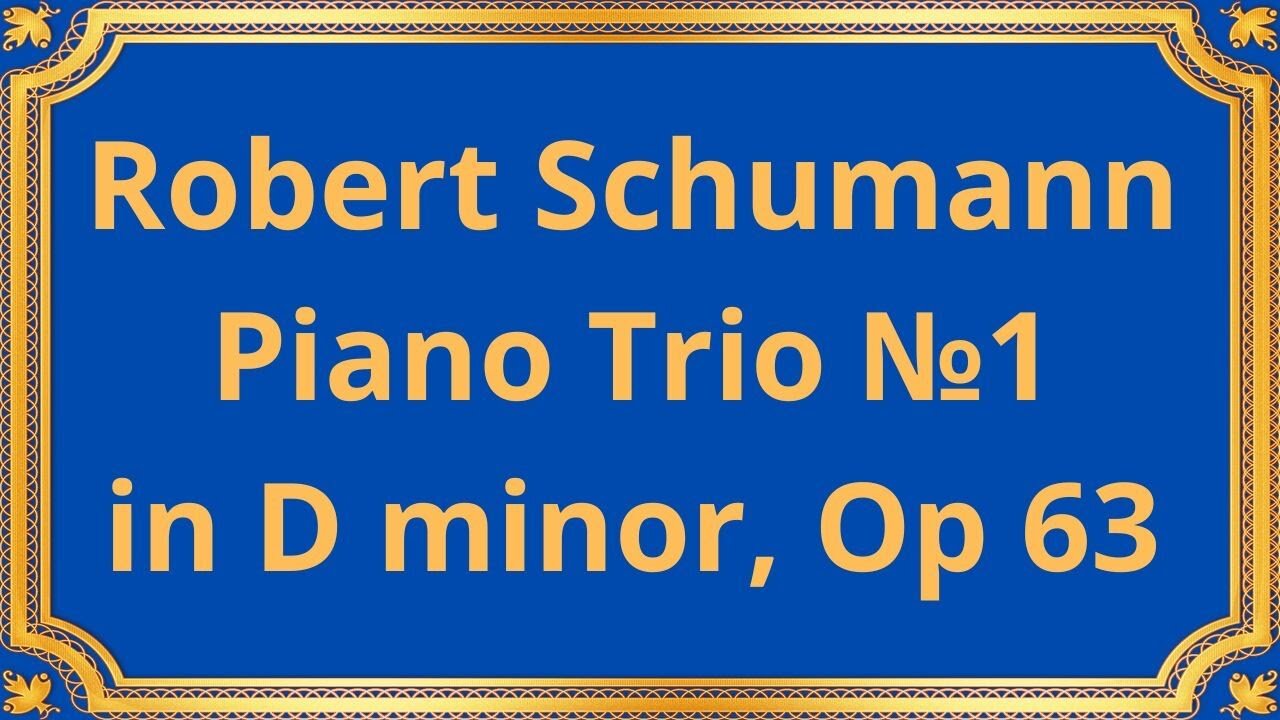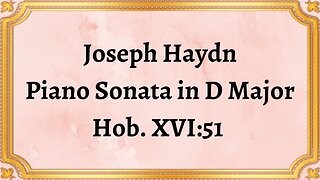Premium Only Content

Robert Schumann Piano Trio №1 in D minor, Op 63
#RobertSchumann #PianoTrio #ClassicalMusic #MusicalComposition #DMinor #Op63 #ChamberMusic #MusicPerformance #MusicHistory #MusicAppreciation
Beaux Arts Trio
Robert Schumann's Piano Trio No. 1 in D minor, Op. 63 is a remarkable composition that showcases the genius of one of the most influential Romantic-era composers. Written in 1847, this piano trio is a captivating blend of emotional depth, technical virtuosity, and melodic beauty.
Robert Schumann, a German composer and music critic, was a prominent figure in the Romantic movement. Composed during a period of immense creative output, the Piano Trio No. 1 reflects Schumann's deep emotional struggles and his longing for artistic expression. It was dedicated to his close friend, the violinist Ferdinand David, and premiered in Leipzig in 1848.
The Piano Trio No. 1 follows the traditional four-movement structure typically found in classical chamber music. The movements are as follows:
1. Mit Energie und Leidenschaft (With Energy and Passion): This movement opens with a bold and dramatic theme, showcasing Schumann's dynamic and expressive style. It features intricate interplay between the piano, violin, and cello, creating a sense of urgency and intensity.
2. Lebhaft, doch nicht zu rasch (Lively, but not too fast): The second movement presents a contrasting mood, with a more lyrical and flowing melody. Schumann expertly weaves together the three instruments, allowing each one to shine individually while maintaining a harmonious ensemble.
3. Langsam, mit inniger Empfindung (Slow, with heartfelt emotion): This movement is characterized by its tender and introspective nature. It displays Schumann's ability to evoke profound emotions through his music, with delicate melodies and rich harmonies that tug at the heartstrings.
4. Mit Feuer (With Fire): The final movement is a tour de force of virtuosity and energy. It showcases Schumann's compositional prowess, with intricate and thrilling passages that demand technical skill from all three musicians. The movement builds to a triumphant and exhilarating finale.
Schumann's Piano Trio No. 1 is known for its expressive melodies, lush harmonies, and innovative use of musical motifs. The composition features intricate counterpoint, where each instrument has a distinct voice while contributing to the overall musical tapestry. Schumann's use of thematic development and variation adds depth and coherence to the piece, creating a sense of unity throughout.
Conclusion:
Robert Schumann's Piano Trio No. 1 in D minor, Op. 63 stands as a testament to the composer's immense talent and profound emotional depth. Its combination of technical brilliance, lyrical beauty, and expressive power make it a beloved work in the chamber music repertoire. This composition continues to captivate audiences with its Romantic sensibilities and serves as a testament to Schumann's enduring legacy in the world of classical music.
You have the opportunity to support the channel:
https://destream.net/live/RadSiarAl/donate
https://www.buymeacoffee.com/6355radsiaral
-
 6:07
6:07
Classical music_Music Inspiration
4 days agoJoseph Haydn Piano Sonata in D Major, Hob. XVI:51
331 -
 LIVE
LIVE
The StoneZONE with Roger Stone
2 hours agoJ6 Martyr Enrique Tarrio Describes Inhumane Prison Conditions Ordered by Biden | The StoneZONE
809 watching -
 16:48
16:48
Tundra Tactical
1 hour agoAffordable Medical Gear From ACETAC SHOT Show 2025
3.58K1 -
 1:46:16
1:46:16
Redacted News
5 hours agoRFK CONFIRMATION: Kennedy goes to WAR with Big Pharma Democrats in Fiery Hearing | Redacted Live
129K275 -
 57:31
57:31
Candace Show Podcast
5 hours agoBREAKING! Taylor Swift Turns Against Blake Lively & Ryan Reynolds | Candace Ep 141
146K162 -
 1:04:59
1:04:59
Sarah Westall
2 hours agoRFK Jr Report, Constitution Suspended, War Time Procedures in Place, WHO Exit, DOD w/ Sasha Latypova
14.5K3 -
 1:56:37
1:56:37
Melonie Mac
6 hours agoGo Boom Live Ep 35!
28K9 -
 1:01:13
1:01:13
LFA TV
9 hours agoPRESIDENT TRUMP SIGNS LAKEN RILEY ACT | BASED AMERICA 1.29.25 6pm
42K4 -

2 MIKES LIVE
3 hours ago2 MIKES LIVE #172 News Breakdown Wednesday!
16.4K2 -
 1:26:16
1:26:16
The Big Mig™
4 hours agoJ6’r Ryan Samsel Free At Last The BOP & DOJ Exposed
18.3K3